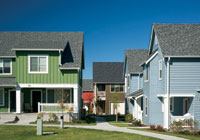But an energy-efficiency strategy also can be as simple as how you orient the house, says architect Peter Pfeiffer, principal of Barley & Pfeiffer Architects in Austin, Texas: “The city of Austin did a study 15 years ago that showed that if production builders simply altered the exterior elevations of their plans to reflect the way the house is facing, they could cut the energy consumption in half.”
For example, a house with a west-facing front would have fewer windows and a shading porch to deal with the harsh sunlight, whereas a house with a north-facing front could have more windows. As Pfeiffer notes, a single-pane window in the shade is more efficient than an insulated window in the sun.
A tight building envelope also is extremely important, Pfeiffer says, because a leaky house is responsible for a large amount of wasted energy. “Air infiltration is probably the second major source of energy consumption or cause of excess energy consumption [after poor site orientation],” he says. It’s essential that builders use housewrap, Pfeiffer cautions.
One builder that has spent a fair amount of time improving the tightness of its building envelopes is McStain Neighborhoods in Louisville, Colo., one of the early pioneers in building and marketing green homes. In addition to DuPont Tyvek housewrap, McStain is big on properly installed window, door, and roof flashing, says Jeff Mednick, the company’s special projects manager.
 McStain builds primarily with engineered framing lumber and finger-jointed studs (to reduce landfill waste), tankless water heaters, low-E windows, and 2×6 exterior walls with blown-in cellulose insulation. Under the Energy Star program, the builder tests all of its homes for tightness, and it recently started experimenting with sprayed foam insulation–an excellent product for creating a tight building envelope. “It is superior to fiberglass because it stops airflow and stops humidity,” Pfeiffer explains.
McStain builds primarily with engineered framing lumber and finger-jointed studs (to reduce landfill waste), tankless water heaters, low-E windows, and 2×6 exterior walls with blown-in cellulose insulation. Under the Energy Star program, the builder tests all of its homes for tightness, and it recently started experimenting with sprayed foam insulation–an excellent product for creating a tight building envelope. “It is superior to fiberglass because it stops airflow and stops humidity,” Pfeiffer explains.
One could argue that it is easier for the company to implement a green building program than it would be for a larger builder. But size doesn’t matter. For example, Los Angeles-based Pardee Homes, which builds about 3,000 homes a year, made a commitment in 2001 to build all Energy Star homes, and it took the company less than a year to phase in the program. “We now use some form of green principles in all our houses, but Living Smart is our sustainable brand,” says marketing vice president Joyce Mason.
Pardee’s homes feature sealed duct systems to eliminate air leaks into nonliving spaces, highly efficient glazing, fluorescent lighting, and photovoltaic cells for solar electric power, among other items. The homes exceed federal codes by 30 percent, Mason says.
Pfeiffer and Languell contend that it’s even more important for high-volume builders to use sustainable techniques because these builders are responsible for up to 95 percent of the new homes in the country. “We could build custom homes one at a time to be totally efficient or off the [electrical] grid, but baby steps with large builders have a much more cumulative effect on the problem,” Languell says.
Cost Concerns
Most builders agree that sustainable homes provide energy and health benefits, but many believe cost is a problem, which is why production builders have been slower to incorporate sustainability features than architects and custom builders with wealthy clients who can afford to pay more for such items.
“Some builders feel that it impacts [up-front] cost and that there may not be a payback,” says Robert Rivinius, president and CEO of the California Building Industry Association in Sacramento. “We believe [green building] needs to be voluntary, and it needs to be cost-effective,” says Rivinius, arguing that California’s already strict energy codes play a role in the state’s lagging homeownership numbers. “You have to have people who are willing to pay the cost,” he continues.
Some builders have done exactly that. Naples, Fla.-based Gulfstream Homes vice president Steve Peel estimates that green building features increase the price of his company’s average house by $4,500 to $6,500, but he believes the features have helped propel sales nonetheless, although he can’t quantify exactly how much because the Naples market has been so hot.
